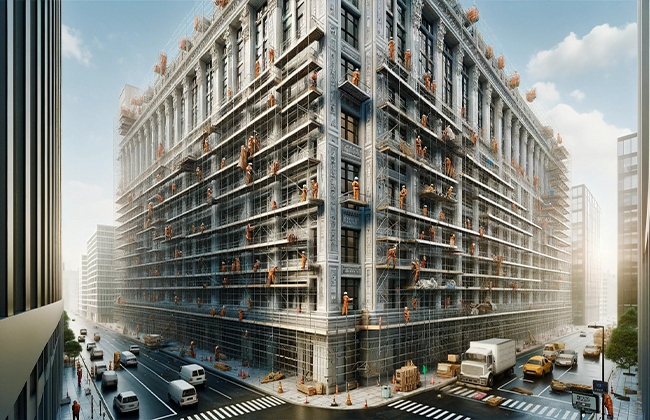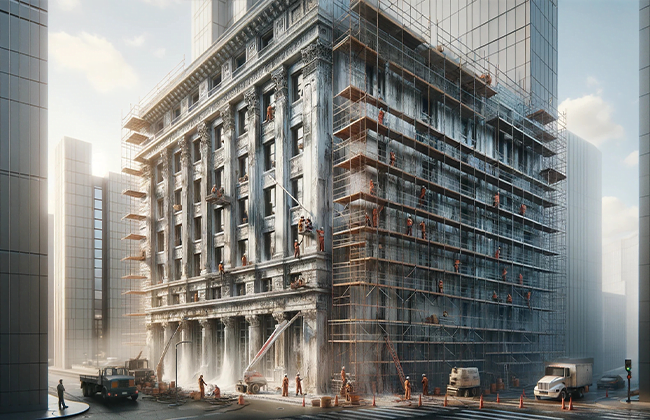Facade repair is essential for maintaining the structural integrity and aesthetic value of your building. Over time, environmental factors such as weather, pollution, and natural wear and tear can degrade your building’s exterior. This guide delves into the best practices for façade repair, ensuring your property not only looks great but is also safe and durable. Let’s ensure your building’s facade gets the care it deserves.
Table of Contents
What is Facade Repair?
Façade repair involves a range of activities focused on restoring the exterior surfaces of buildings to their optimal condition. These activities vary widely, from minor cosmetic touch-ups that address aesthetic concerns to comprehensive structural overhauls necessary for ensuring safety and extending the lifespan of the building materials. Depending on the damage extent and the building materials involved, different techniques and approaches are employed. It’s essential for building owners to understand these differences, as the right approach can prevent further damage and save on future costs.
Understanding the Importance of Regular Facade Maintenance
Keeping up with regular facade maintenance is like giving your building a health check—it catches the small issues before they turn into big headaches. It’s all about staying ahead of the game and ensuring your building remains safe and stunning.
Why Facade Maintenance is Crucial
Regular maintenance of a building’s façade is more than just a cosmetic concern—it’s a critical practice that helps avoid severe structural issues over time. Routine inspections and minor repairs play a significant role in this process, extending the exterior’s longevity and helping to cut down on costly repairs down the line. Let’s talk about why sticking to a regular maintenance schedule isn’t just a good practice—it’s essential.
Transitioning into benefits:
Maintaining the façade isn’t only about keeping your building looking good. It’s also about safeguarding your investment. Regular upkeep ensures that minor problems are addressed before they evolve into major, more expensive issues. Here’s what regular facade maintenance offers:
Benefits of Maintaining Your Facade
- Enhances Building Safety: Regular checks and fixes help identify and mitigate potential hazards that could compromise the building’s structural integrity and safety.
- Preserves Property Value: A well-maintained facade boosts curb appeal, which can significantly influence the property’s market value. It’s like keeping your building’s resume polished; first impressions matter to potential buyers or renters.
- Improves Aesthetic Appeal: An attractive exterior can make a world of difference in how a building is perceived. Whether it’s residential or commercial, a good-looking facade can enhance the overall aesthetic of the neighborhood and make the property stand out.
Types of Facade Damage
Every building has its scars and stories, but do you know what common damages to look out for on your facade? Recognizing these can be the key to timely and effective repairs, keeping your building in top shape.
Common Issues with Building Exteriors
Recognizing the common types of damage that can affect building facades is crucial for timely intervention and repair. In this section, we’ll explore the most frequent issues such as cracks, water leaks, and discoloration. Identifying these problems early can save you a lot of hassle and expense in the long run.
Let’s dive deeper into each of these concerns:
Cracks and Structural Issues
Cracks in the facade are not just unsightly; they can also be signs of deeper structural problems that may compromise the building’s integrity. These can range from hairline fractures, which are often cosmetic, to deep cracks that signal serious structural distress.
How to Spot and Address Cracks:
- Visual Inspection: Regularly walk around your property to check for any visible signs of cracking.
- Monitor Progression: Once you’ve spotted a crack, keep an eye on it to see if it’s getting worse, which can help you decide when to act.
- Consult Professionals: For significant cracks, it’s wise to bring in structural engineers or facade restoration experts who can assess the damage and recommend the best repair methods.
By staying vigilant and addressing cracks early, you can prevent them from becoming major threats to your building’s structure.
Water Leakage and Its Prevention
Water infiltration is another common issue that can cause extensive damage to building exteriors. If not handled properly, water can seep into structural cavities and erode the building materials, leading to costly repairs.
Effective Strategies for Waterproofing and Repair:
- Proper Sealing: Ensure that all joints and openings in the facade are properly sealed to prevent water entry.
- Regular Maintenance: Check and clean gutters, downspouts, and drainage systems regularly to ensure they are not blocked and are directing water away from the building effectively.
- Use of Water-Repellent Coatings: Applying water-repellent materials to the facade can significantly reduce water absorption and help protect the building’s exterior.
Addressing water leaks not only helps in maintaining the aesthetic appeal of your building but also preserves its structural integrity by preventing moisture-related deterioration.
Repair Techniques

Different problems require different solutions, especially when it comes to fixing your building’s facade. This section dives into the various repair techniques that cater to different materials, ensuring your repairs are done right.
Choosing the Right Repair Method
Choosing the appropriate method for facade repair is critical, as different materials will require distinct approaches. It’s not only about fixing the current damage but also about ensuring that the repairs last. This section explores the most effective repair techniques for common materials such as brick, stone, concrete, and others. Each material has its unique characteristics and vulnerabilities, and understanding these can greatly improve the effectiveness of your repair efforts.
Now, let’s look at some specific materials and the recommended repair methods:
Brick Facade Repair
Brick facades are popular due to their durability and aesthetic appeal, but they are not immune to damage. Over time, bricks can deteriorate due to weathering, moisture, and thermal expansion.
Key Considerations for Brick Repair:
- Repointing: This involves renewing the external part of mortar joints, a critical practice as it prevents water ingress that can lead to further deterioration.
- Brick Replacement: When bricks are too damaged to be repaired, replacing them is necessary. Matching the new bricks with the existing ones in terms of color and texture is crucial to maintain the uniformity of the facade.
- Cleaning: Sometimes, simply cleaning the bricks can restore much of the facade’s appearance. However, it’s important to use the right techniques to avoid damaging the brick and mortar.
By focusing on these aspects, you can significantly enhance the longevity and appearance of your brick facade.
Concrete Facade Repair
Concrete is another commonly used material that’s prone to specific types of damage such as spalling and cracking. These issues not only affect the building’s look but can also compromise structural integrity if not addressed properly.
Strategies for Concrete Repair:
- Sealing Cracks: Small cracks in concrete can often be sealed using epoxy or polyurethane foam. This not only repairs the cracks but also prevents water from entering and causing further damage.
- Addressing Spalling: Spalling occurs when water enters concrete and forces the surface to peel, pop out, or flake off. Repairing spalled concrete may involve removing loose concrete, treating the exposed rebar with rust inhibitor, and applying a new concrete overlay.
- Protective Coatings: Applying protective coatings can prevent future damage by providing a barrier against harmful elements.
These techniques can help maintain the structural health and aesthetic value of concrete buildings, ensuring they stand strong and look great for years to come.
Facade Repair Costs
Talking about money might not be fun, but understanding the potential costs involved in facade repair is crucial. We’ll break down what factors into the cost so you can budget wisely without any surprises.
Estimating Your Repair Budget
When planning facade repairs, understanding the costs involved is crucial. This section will break down the factors that influence repair costs and offer practical advice for setting a realistic budget. Whether you’re facing minor aesthetic tweaks or major structural repairs, having a clear financial plan will help you manage the process without unexpected expenses throwing you off course.
Let’s discuss the components that can affect your repair budget:
- Extent of Damage: Naturally, more extensive damage will require a more substantial investment.
- Material Costs: Different materials have different costs. For example, replacing stone will typically be more expensive than brick.
- Labor Costs: The complexity of the job and the skill level of the workers needed will also impact the cost.
- Location: Costs can vary significantly depending on the region due to differences in labor rates and material availability.
- Permitting Fees: Don’t forget to factor in the cost of any necessary permits, which can vary by location and scope of work.
DIY vs. Professional Repairs
Deciding whether to handle facade repairs yourself or to hire professionals is a significant decision that can affect both the cost and the quality of the work.
When You Might Consider DIY:
- Minor Repairs: Small cracks or repainting that require minimal specialized skills can often be handled by a competent DIYer.
- Cost Savings: If you have the necessary skills, DIY can reduce costs by eliminating labor expenses.
When to Hire Professionals:
- Major Structural Repairs: For anything that could affect the structural integrity of the building, professional expertise is crucial.
- High-Quality Finish: Professionals will likely deliver a higher-quality finish, which is important for maintaining both the appearance and the value of the property.
- Safety: Working on exteriors, especially on tall buildings, can be dangerous without the proper equipment and training.
Costing Table for Common Facade Repairs
Below is a table detailing approximate costs for common facade repairs, offering a comparative look at DIY versus professional repair costs. Keep in mind, these are estimates and actual costs can vary based on local pricing and the specific conditions of the building.
| Repair Type | DIY Cost (Materials Only) | Professional Cost (Materials + Labor) |
| Crack Sealing | $50 – $100 | $200 – $400 |
| Repointing Brick | $150 – $300 | $500 – $1,000 |
| Painting Exterior | $100 – $300 | $1,000 – $3,000 |
| Replacing Damaged Bricks | $100 – $200 | $400 – $800 |
| Applying Water Repellant | $100 – $200 | $500 – $1,500 |
Note: These prices are for illustrative purposes only. It’s essential to get quotes from local contractors to get a more accurate idea of what your repairs will cost.
Preventative Measures
An ounce of prevention is worth a pound of cure, especially with building maintenance. Let’s go through some preventative measures that can save you from future damage and repair costs. It’s all about keeping your building healthy and happy for the long haul.
Preventing Future Damage
Maintaining a facade isn’t just about reacting to damage—it’s equally important to take proactive steps to prevent issues from arising in the first place. By implementing effective preventative measures, you can significantly reduce the need for frequent repairs, extend the lifespan of your building’s exterior, and ensure it continues to look its best. Let’s explore some strategies that can help shield your facade from damage.
Effective preventative measures include:
- Regular Inspections: Routine checks are the first line of defense against facade deterioration. By scheduling inspections at least once or twice a year, you can catch and address small issues before they turn into larger problems. Especially after extreme weather conditions, these inspections are crucial.
- Protective Treatments: Applying treatments such as water-repellent coatings or anti-graffiti sealants can protect your facade from environmental elements and vandalism, respectively. These treatments help maintain the aesthetic and structural integrity of the building.
- Timely Cleaning: Accumulation of dirt, debris, and biological growth like moss or algae can cause or exacerbate damage to the facade. Regular cleaning not only keeps the building looking fresh but also prevents the long-term damage these materials can cause.
- Vegetation Control: Trees and shrubs can cause unexpected damage to your facade if not properly managed. Ensure that all vegetation near your building is trimmed back to prevent branches from rubbing against the facade and roots from undermining the foundation.
- Gutter Maintenance: Ensure that all gutters and downspouts are clear of debris to prevent water buildup. Water should be directed away from the building to avoid foundation and exterior wall damage.
By focusing on these preventative strategies, you can greatly reduce potential damage and the associated repair costs. This proactive approach not only preserves the appearance and integrity of your building but also contributes to a safer and more durable structure.
Remember: Prevention is always better than cure. Investing a little time and effort in these measures now can save you a lot of trouble and expense in the future.
Conclusion
As we’ve explored in this guide, facade repair is not just about fixing current issues but also about preventing future problems. Regular maintenance, understanding the types of damage, and choosing the right repair techniques are all crucial steps in preserving the lifespan and beauty of your building. Remember, a well-maintained facade boosts property value and provides a safe environment for occupants. Keep these tips in mind to ensure your façade remains in top condition.
FAQs
Q: What are the first steps in planning a facade repair?
A: When planning a facade repair, start by assessing the extent of the damage. This might involve hiring a professional to conduct a thorough inspection. Based on the findings, you can prioritize the necessary repairs and begin sourcing the materials and expertise needed.
Q: How often should facade repair be conducted on a typical commercial building?
A: Facade repair frequency depends on various factors including building material and local climate conditions. Generally, it’s wise to conduct a professional inspection every 5 to 10 years, or sooner if signs of damage like cracks or discoloration appear.
Q: Can facade repair improve energy efficiency in my building?
A: Absolutely, facade repair can significantly enhance your building’s energy efficiency. By sealing leaks and adding insulation as part of the repair process, you can reduce air infiltration and thermal bridging, leading to lower heating and cooling costs.
Q: What are the risks of delaying facade repair?
A: Delaying facade repair can lead to increased damage, which can escalate repair costs and potentially compromise the building’s structural integrity. Early intervention is key to preventing minor issues from becoming major, costly repairs.
Q: Is it necessary to hire professionals for facade repair, or can I do it myself?
A: For minor cosmetic repairs, a DIY approach might be feasible. However, for any structural or extensive damage, hiring professionals is recommended. They have the right tools, skills, and knowledge to ensure the repairs are done safely and effectively.




